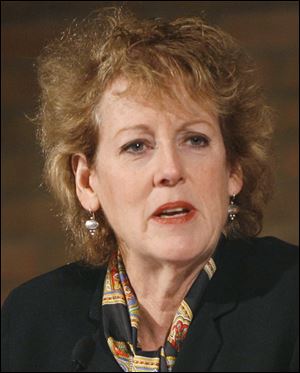
Ohio chief justice starts discussion on judicial election changes
5/9/2013
Ohio Supreme Court Chief Justice Maureen O'Connor
COLUMBUS — Should Ohio judicial elections go entirely non-partisan on the ballot?
Should Ohio switch to some non-partisan process when it comes to a governor filling judicial vacancies, and should those appointments require state Senate confirmation?
In a Cleveland appearance today before the Ohio State Bar Association, Chief Justice Maureen O’Connor put eight topics on the table for discussion that she hopes will lead to a firm judicial election reform plan by the end of the year.
The plan skirts the political hot potato of replacing elections with a form of merit appointment process.
“Over the last 75 years, there have been opportunities to switch to a merit selection, which would require a constitutional amendment, but time and again voters have reaffirmed by large margins, 2 to 1, that they want judges to be accountable in competitive elections…,” she said. “So, I believe it is time to move on from judicial selection and talk about what we can do to strengthen our existing system of judicial elections.”
The topics also don’t touch on the controversies over the influence of campaign cash in judicial elections. Both issues were being explored by the chief justice’s veteran predecessor, Thomas Moyer, at the time of his death in 2010.
Justice O’Connor, a Republican, goes in the opposite direction from where Democrats want to go when it comes to partisan labels appearing next to judicial candidates’ names on the ballot.
Currently, judges in Ohio run in partisan primary elections but run without party labels in the general election. Democrats have sued to have political labels added to the November ballot, but Chief Justice O’Connor instead asked whether the primary label should also be removed.
“Some scholars and other observers have argued that party affiliation is a valuable cue to voters, particularly in low-information races like judicial races,” Chief Justice O’Connor said. “They advocate taking the opposite approach and adding partisan labels to judge races in the general election.”
She garnered applause when she added, “I respectfully disagree. Party affiliation has no place in judicial elections. Period.”
Other questions posed included:
— Should Ohio stop placing judicial races at the bottom of the ballot, a move that leads to a huge drop-off in voter participation?
— Should all judicial elections be held in odd-numbered years where they might get more attention?
— Should Ohio increase the minimum qualifications required to serve as judge?
— Should the length of judicial terms be increased?
— Should Ohio centralize and expand its civic education programming, create a judicial voter guide, and expand use of cameras in courtrooms beyond the state Supreme Court?
“This is just an opportunity to start the discussion,” Chief Justice O’Connor said. She urged participation in the process by going to www.OhioCourts2013.org.
Contact Jim Provance at: jprovance@theblade.com or 614-221-0496.